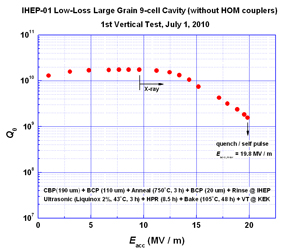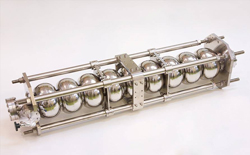 |
 |
|||||||||||||
|
|||||||||||||
|
|||||||||||||
|
A 1.3-Gigahertz low-loss type large-grain nine-cell superconducting cavity called IHEP-01 produced at the Institute of High Energy Physics (IHEP) in Beijing, China, achieved an accelerating gradient of 20 Megavolts per metre in its first vertical test at KEK on 1 July. This may not be the design gradient yet, but it marks an important progress on the research and development of superconducting radio frequency (SRF) technology in China. The cavity is made of large-grain niobium from Orient Tantalum Industry Corp. (OTIC), Ningxia. Its fabrication started in February 2009 and finished in April 2010 after electron beam welding (EBW), followed by centrifugal barrel polishing, buffered chemical polishing and pre-tuning with the newly developed SRF facilities at IHEP. “We started the nine-cell cavity fabrication with the experiences gained at IHEP only on single cell cavities, without other intermediate steps. And this strategy saves quite a lot of time and cost to arrive at nine-cell cavity,” said Jie Gao, the ILC group leader of IHEP and chair of ALCSC (Asian Linear Collider Steering Committee).
On 4 June, the cavity arrived at KEK for ultrasonic cleaning and high-pressure rinsing and was vertically tested at a temperature of 2 K on 1 July. During the test, it was found that strong field emission exists, and a first solution might be to improve the iris surface condition in the following surface treatment. The limiting factor for the quench to happen might be the EBW-related defects on the equators of an end cell, which could be removed by the further surface treatments. Besides, the test result shows that there are three mid cells where the accelerating field reached 32MV/m. “If the iris surface condition and equator EBW quality are well controlled, with polishing, the cavity could reach a high accelerating gradient above 30MV/m,” Gao believes. The second test will be arranged in the later half of this year. IHEP-01 is the first low loss type 9-cell cavity in China , and the R&D work, supported through the IHEP Innovation Program, started at the end of 2008. The 1.3-GHz nine-cell cavity is the most important key component, and the test proves that a key step has been made toward the accomplishment of the programme. “IHEP-01 is the milestone of IHEP superconducting technology development,” said Shin-ichi Kurokawa, the former chair of the International Linear Collider Steering Committee (ILCSC) in the congratulation mail. -- Min Zhang |
|||||||||||||
| © International Linear Collider |

